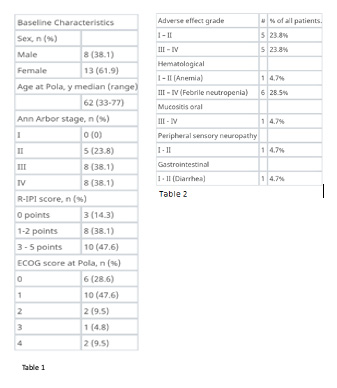INTRODUCTION:
Diffuse Large B-cell Lymphoma (DLBCL) is a prevalent and aggressive subtype of non-Hodgkin's lymphoma. Accurate diagnosis and timely treatment are crucial for improving patient outcomes.
Polatuzumab vedotin has emerged as a promising therapeutic option in the management of Diffuse Large B-cell Lymphoma (DLBCL). Polatuzumab vedotin is a monoclonal antibody conjugated to a chemotherapeutic agent, monomethyl auristatin E (MMAE), which binds to the CD79b antigen specific to B cells and internalizes into malignant cells. (Hervé, et. al. NEJM 2022)
POLARIX trial has shown that first-line treatment with the Pola-R-CHP combination, showed a progression-free survival benefit over the R-CHOP regimen at 2 years and had a similar safety profile, other prospective therapeutic trials have shown benefit of polatuzumab based therapy in Relapsed/Refactory DLBCL. (Herrera, et. al. Blood 2022) (Sehn, et. al JCO 2020) In Mexico, Polatuzumab + R-CHP (Pola-R-CHP) was recently approved for previously untreated or Relapse/Refractory (R/R) DLBCL patients and until this date to the best of our knowledge this is the first study in our country that evaluates response rates with polatuzumab-based protocols.
METHODS:
We conducted an observational, retrospective, multicenter study focusing on the effectiveness and safety of Pola-R-CHP in adult patients with previously untreated or R/R DLBCL across 12 private centers in Mexico. We collected data of 21 patients who received at least one dose of Pola-R-CHP between October 2022 and July 2023. The primary endpoint of the study was the overall response rate (ORR), defined as the sum of complete response (CR) and partial response (PR). We also described the type, incidence, severity of any adverse events (AEs) from the start of treatment to 1 month after the last infusion.
Positron Emission Tomography response assessment was accordingly to Lugano criteria. AEs were assessed according to the National Cancer Institute Common Terminology Criteria of AEs and to minimize bias, a terminology dictionary was provided to all Centers.
Descriptive analyses included medians and ranges for continuous variables, and frequencies and proportions for categorical variables.
RESULTS:
Twenty-one patients were enrolled with diagnosis of DLBCL, 8 females (38.1%) and 13 males (61.9%). The median age was 62 years (range = 34 - 77).
Three patients (14.3%) were classified as R-IPI 0 points, 8 patients (38.1%) as 1-2 points and 10 patients (47.6%) as 3-5 points. Most patients (76.2%) were in stage III/IV with an ECOG performance status score of 0 - 1 (76.2%). Six patients (28.5%) were classified as Triple-Hit DLBCL subtype.
Eight patients (38.1%) were previously untreated, 7 patients (33.3%) received Pola-R-CHP as second line, and 6 patients (28.6%) as third line treatment. Median number of cycles was 6 (range: 1 - 6).
The ORR was 66.6%, with 13 patients (61.9%) with complete response and 1 patient (4.7%) with partial response. Complete response rates among first line patients and subsequent lines were 75% and 53.8% respectively.
Thirteen (62%) patients received at least 6 cycles of treatment and 8 patients (38%) suspended treatment due to AEs(1 patient), progression (2 patients) or death (5 patients).
Ten patients (47.6%) presented at least one AEs as enlisted in the table 2.
CONCLUSIONS:
Polatuzumab vedotin has emerged as an innovative therapeutic option in the management of DBLCL. The experience in developing countries is limited and the outcomes, unexplored. In our study, Pola-R-CHP ORR was 66.6% with an acceptable safety profile. We need to conduct studies with a larger group of patients and longer follow-up in order to determine OS and Progression Free Survival (PFS) and to introduce this protocol in routine treatment algorithms.
Disclosures
No relevant conflicts of interest to declare.


